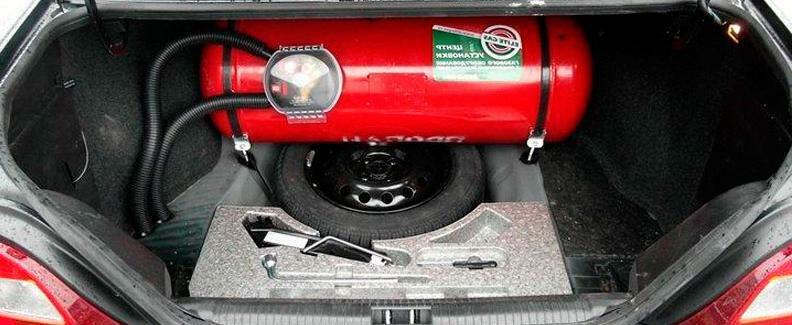A gas cylinder at a summer cottage or in a country house is a familiar phenomenon, but extremely troublesome. After all, the supply of blue fuel in them will have to be periodically restored, observing the rules for refueling household gas cylinders at the filling station. And the cylinders themselves must meet special conditions.
You will learn all about the norms and requirements for filling tanks with liquefied gas from our article. We will tell you about which cylinders are suitable for refueling and further operation, where and how to make it better. We will warn you about the problems that most often accompany this event.
The content of the article:
- What does the legislation say?
- Danger of filling cylinders at gas stations without a license
-
Types and features of gas storage cylinders
- Types of tanks for household use
- How do color and purpose relate?
- Inspection of cylinders. How to find out the service life
- Why is it not worth refueling at regular gas stations?
- Gas filling station services
- Cylinder filling rules
-
Which is better: exchange or refueling?
- What problems can lie in wait when refueling
- Replacing the cylinder with a new one, repair
- Replacement procedure, safety during transportation
- Several important nuances of operation
- Conclusions and useful video on the topic
What does the legislation say?
Gas stations, gas distribution stations and other gas supply facilities belong to the most difficult operational category. The legislation provides for strict safety rules, in accordance with which all actions are carried out at the facilities and the surrounding area.
The storage and operation of a gas cylinder in the domestic sphere is explained by the decree of the Government of the Russian Federation of December 26, 2016 No. №1498. It regulates the provision of utilities and the operation of common property. One of the points describes the purchase, refueling and exchange of household gas cylinders.
Important highlights that matter to everyone types of gas cylinders:
- the cylinder must be serviceable;
- have unexpired shelf life;
- sale is carried out only in special licensed points;
- refueling is carried out at "gas filling stations".
It follows that refueling at ordinary automobile gas stations is prohibited by the rules for the design and use of equipment operating under pressure. And this is not a whim of legislation, but a real act of care for citizens.
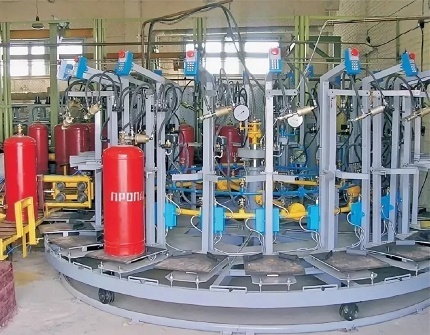
It is best to contact reliable, specially equipped Gas Filling Stations (GNS) designed for refueling household cylinders
Danger of filling cylinders at gas stations without a license
The fact is that household and automobile cylinders differ in design: the latter have special cut-off devices that do not allow the tank to overflow.
The gas supply system turns off automatically when the norm is reached (no higher than 85%). And in cylinders, the purpose of which is household use, such cut-off devices are not provided. Another caveat - automotive systems are filled in liters, and household systems - in kilograms.
In licensed "gas filling stations" this issue is solved simply - the cylinder is filled on the scales. Everything is done taking into account the amount of residues and the newly supplied gas. The tank itself must be checked for leaks, service life, the presence of residues of heavy fractions.
Since 2017, household gas cylinders have ceased to be filled at ordinary gas stations for cars. On the one hand, it is clear that after several accidents with explosions, government agencies drew attention to this problem. However, on the other hand, they have not yet been able to solve it completely due to the lack of licensed items.
And if, when contacting a car Gas station you will be filled with a cylinder, know: both you and the filling station are breaking the law.
Let us consider what legal possibilities we have for filling the cylinder with gas, what are the basic rules according to which they refuel household gas cylinders at Gas station, as well as other important information on the operation of gas equipment with removable media.
Types and features of gas storage cylinders
Manufacturers produce several types of steel cylinders of different volumes: 5, 15, 25 and 50 liters. Weight - from 4 to 22 kg. For example, a 50 liter bottle weighs 44 kg. Recently, cylinders made of polymer composite materials in volumes of 14 or 33 liters have been developed and produced.
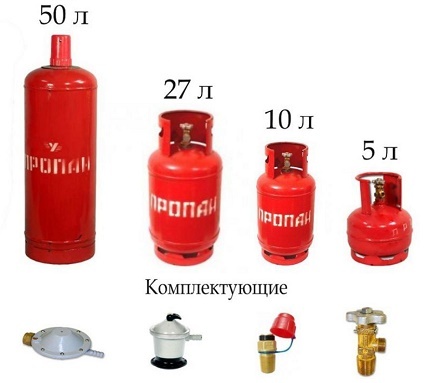
For rare seasonal use, small models of 5-12 liters can be purchased. For year-round and intensive use, choose 50-liter cylinders
Types of tanks for household use
According to the material from which the body is made, cylinders for domestic use are divided into the following groups:
- Steel cylinders - strong and durable. Welding seams are their vulnerable moment, therefore great attention is paid to the inspection of welded seams when purchasing and examining them. It is recommended to select the correct location for the installation of the equipment, excluding places of high humidity, so as not to corrode the steel models.
- Composite containers. This is a more modern version. Composite gas cylinder It is also quite durable, it costs 2-3 times more due to the high cost of materials containing fiberglass. Strengthens the strength of the additional protection of the case.
Polymer cylinders are easier to transport as they weigh less and deform less when hit or dropped. Another advantage of polymer equipment is high heat resistance. It can be near fire.
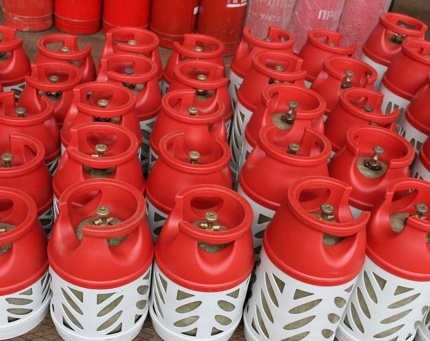
Composite polypropylene euro cylinders are safe, easy to dispose of, convenient to use, but more expensive
How do color and purpose relate?
According to the GOST rules, the color of the balloon determines their purpose:
- white ones with yellow inscriptions are filled with acetylene;
- red - for propane;
- blue - for medical or conventional oxygen;
- hydrogen is stored in dark green;
- in gray with black elements - nitrous oxide.
For use in our domestic environment and for regular replenishment of liquefied fuel, only red tanks with the corresponding marking are suitable.
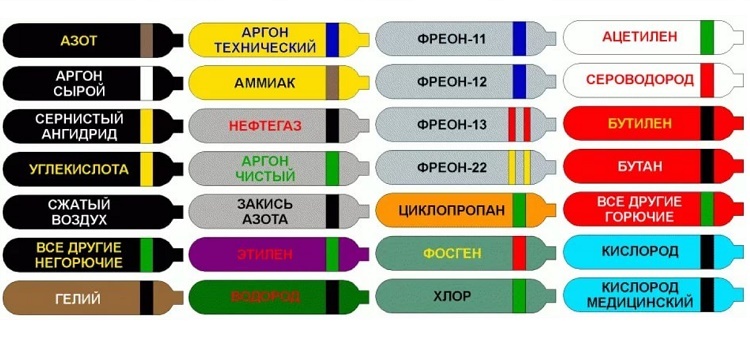
The Russian paint scheme for cylinders is impossible to confuse! For domestic use of gas equipment, only red options are suitable
Inspection of cylinders. How to find out the service life
Domestic propane cylinders are metal sealed containers of a certain volume for storing gas. Manufacturing material - steel alloy with additions of chromium and molybdenum. From the manufacturer they get into free circulation. They are used in specialized companies as equipment, in enterprises, in the household of the population.
Each cylinder is accompanied by the issuance of a paper passport from the manufacturer. The data is duplicated in the form of metal inscriptions on the back of the case, next to the enterprise's mark.
The technical condition of the cylinders must be strictly controlled in accordance with GOST 15860. To determine the possibility of further operation, a survey procedure is carried out.
Subject to the survey once every five years:
- products manufactured before February 2014 can last up to 40 years;
- products manufactured after February 1, 2014 - up to 20 years.
The "metal passport" indicates the date of release of the product, volume, weight, date of the last survey. According to the rules of use, cylinders without metal passports or with indistinct inscriptions are not refueled and cannot be exchanged.
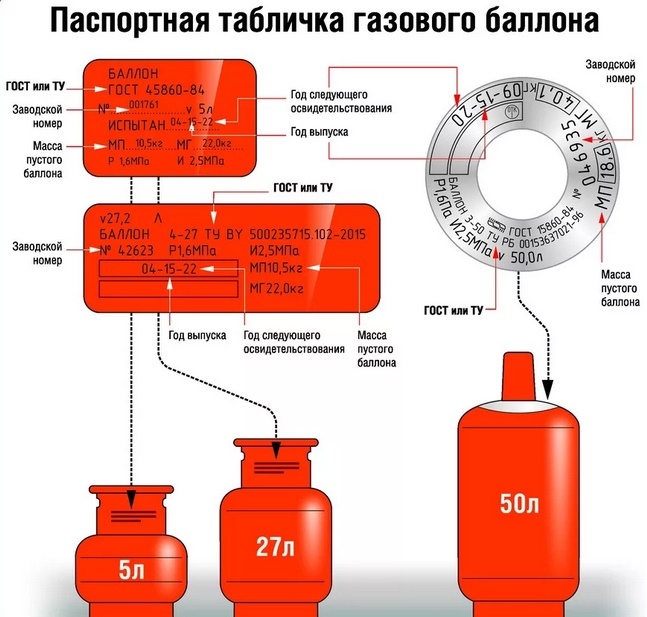
On the body of the nameplate, data on the mass, date of production, date of the last certification are applied. It is important to treat the product with care so that the inscriptions are well read, otherwise the cylinder will be taken out of service.
And it is right. The "life" of each cylinder proceeds in a different way: some products are in constant use, others can gather dust in the garage for years in order to be used at the right time for certain goals.
Do not forget that faulty equipment for storing hazardous substances (gas) can bring trouble.
Why you shouldn't refuel on regular Gas station?
The question of whether it is possible to refuel household gas cylinders at a gas station is worth considering in more detail. According to the legislation, it is possible to sell liquefied gas only in specially equipped points. But many car gas stations, bypassing the law, are trying to make money on it.
When purchasing gas at such a filling station, consumers should remember not only about legal responsibility, but also about the danger posed by an incorrectly filled cylinder.
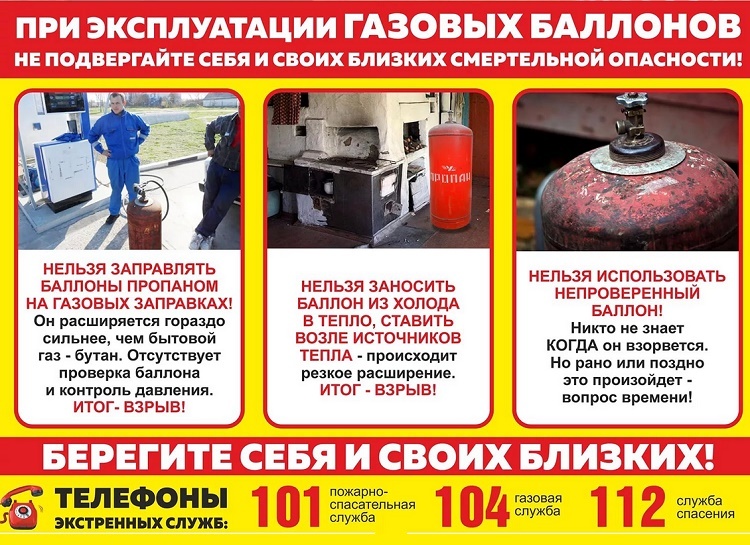
Domestic cylinders can be refueled only at points where there is special equipment and a license. Compliance with the rules indicated in the poster is a prerequisite to guarantee safety
And the risks are great if:
- the container is not tested for leakage;
- inspection control, and therefore, serviceability, is not carried out;
- but the most important thing is that at gas stations there is no way to check the filling rate provided for by the approved standards (85% of the volume).
The free zone creates a "vapor cap" that prevents gas expansion. For example, when heated under the sun. How much liquid substance is needed is easy to calculate by dividing the nominal volume by 1.43. For example, for a 22 liter cylinder, it is enough to add 15.38 liters of liquefied gas.
If there is no cut-off device, the work is carried out literally "by eye", so there is a great possibility of overfilling the container, which means an increase in the possibility of a catastrophic risk.
Therefore, before filling an empty gas cylinder, Gas station, make sure that the item has special equipment for this, including a weighing scale. But it is better to fill the containers at special gas filling stations to ensure weight control is guaranteed.
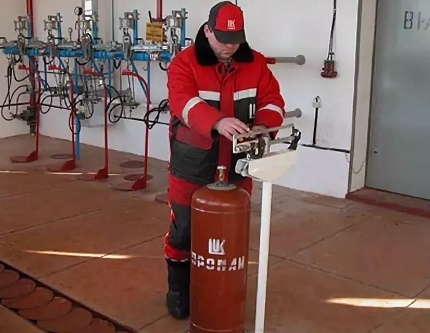
Before refueling, the cylinder is weighed so as not to exceed the permissible weight parameters after refueling.
Gas filling station services
These are companies that refuel gas into any permitted containers. The gas filling station must be equipped with special equipment that determines the method of filling with gas.
There are three ways to refuel with gas:
- pumping;
- pumping and compression;
- pumping and evaporative.
The name of the equipment itself speaks for itself. These are pumps, compressors for creating an increased pressure, an evaporator, a heater for providing an increased pressure. Also must be present: hoods, gas storage tanks, technical equipment (density meters, dispensers).
Mobile modular station - a variant of a small gas distribution station for filling oxygen cylinders, most often used for medical institutions or construction companies that use oxygen for welding works.
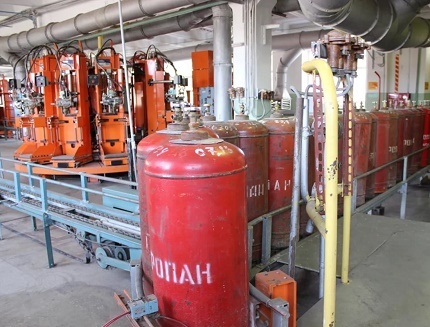
Gas filling stations offer service for changing cylinders, conduct safety briefings, as well as certification and testing for serviceability
Large stations use cylinder filling stations with electronic weighing units, including an industrial controller and a gas supply valve. When the cylinder is installed on the cargo receiving platform of the scales, the amount of residues and the mass of the new receipt are automatically recorded.
When the required volume is reached, set in advance on the electronic unit, the gas supply is automatically stopped.
Cylinder filling rules
Safety requirements are imposed on filling a standard cylinder. Mandatory marking "compressed gas" and a special sticker indicate an explosion hazard.
The equipment must be checked for the following parameters:
- serviceability;
- the presence of residual pressure;
- valve or valve defects;
- the presence of rust on the surface, delamination of the material;
- dents or damage.
Before refueling, condensate and gas residues are removed from the cylinder, it is checked for serviceability.
At specialized stations, inventory is used - a gas supply hose with valves, an adapter - adapter.
Which is better: exchange or refueling?
Obtain a cylinder of gas required for work gas boiler, stove, outdoor lighting lines, etc., in two ways: refuel your container or exchange it for another already filled one.
In the first case, the cylinders are left at the station for 1-2 days, the consumer receives his full container.
In the second, a quick exchange of an empty container for a filled one. Consumers themselves can choose which way to use. The second method is faster, but you get someone else's equipment, perhaps not the newest. The cost depends on the type and volume of gases. Standard case: 200-300 rubles.
What problems can lie in wait when refueling
Nuances that are important to know about filling gas cylinders:
- Some Chinese cylinders have thin walls. They are not designed for heavy loads. It must be remembered that cheap equipment may not pay off due to the high risk.
- Active gases are prone to fire and explosions, therefore, you should especially carefully monitor the volume (85%) when filling with propane, oxygen, methane.
- To use household gas at low temperatures, it is better to use winter propane-butane mixtures, with the advantage of propane, since butane is not very suitable for winter operation.
In order to prevent the occurrence of the listed problems and risks associated with replenishing the stock of a liquefied explosive substance, it is necessary to think over the process in advance and provide for all the nuances.
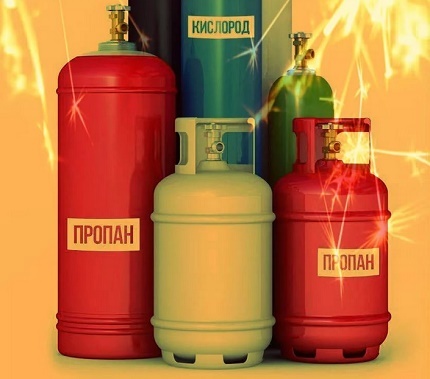
A high-quality cylinder and compliance with operating rules are the key to safety. This characteristic should be treated with increased attention.
Replacing the cylinder with a new one, repair
Sooner or later the balloon wears out, the valve may fail, the surface will begin to exfoliate. Almost every city has a cylinder replacement or repair center. You can give an old one and get a new one, with an additional payment of about 1,500 rubles. This is a good alternative to buying new equipment.
If the valve is to be repaired, it is repaired or completely change. The cylinder itself can be sanded and painted. The cost of a new empty propane cylinder: from 2,500 to 600 rubles, depending on the manufacturer's materials.

It is more profitable to purchase large cylinders - a 50-liter capacity is enough for cooking on the stove for a small family for 2 months
Replacement procedure, safety during transportation
The design of the cylinders differs in the presence of a KB-2 closing valve or a VB-2 technical valve in accordance with GOST 21804–94. In versions with a valve, there is a quick-release reducer that reduces the pressure when a flame appears.
The reducer is attached to the main hose through a nipple with a small mounting clamp:
- The reducer is attached to the cylinder with the valve by pulling it onto the neck of the valve with a sealing ring.
- It is connected to the valve by means of a thread on the valve union, otherwise - by a union nut of the reducer. A special disposable pad is issued at the replacement points.
If the gas pressure has noticeably decreased and fades away, you should not squeeze it out to the last drop:
- Turn off the gas, close the valve and start replacing the cylinder.
- Remember that the gearbox has a left-hand thread. Unscrew the gear nut clockwise.
- Replace the cylinder.
- Prepare paronite replacement gasket. Tighten the nut counterclockwise. The cylinder must be kept strictly upright (never turn it over).
- Be sure to close the valve of the old cylinder, put a plug and a protective cap. This is important because there is always some gas left in the cylinder.
Always close the valve when the stove is not working.
Transportation of cylinders is carried out only with safety caps and plugs. When transporting, make sure that the tap is closed and protected by a cap.
Several important nuances of operation
Simple rules will help you conveniently and safely use cylinders at dachas and in country houses:
- Do not smoke when changing the cylinder. It is forbidden to keep an open flame nearby, check the leakage with a fire (lighter or matches).
- Keep the valve fully open and fully closed when the appliances are turned off.
- Do not operate a power tool in close proximity to a cylinder, so that sparks conductive rotor brushes did not flare up with an imperceptible gas leak.
Compliance with the requirements for the competent and accurate operation of tanks with liquefied gas is a norm that guarantees the safety of the user and others, as well as the safety of property.
He will acquaint you with the nuances and rules for filling gas cartridges required for the operation of burners next article. We recommend reading some very useful information.
Conclusions and useful video on the topic
Refueling fifty-liter balloon. Specialized filling stations have the necessary equipment. The cylinders must be checked for integrity, the valve is inspected. Refueling time is approximately 5-10 minutes. Safety precautions are followed:
Operate your gas equipment with care. Try to protect the case from impacts to prevent gas leaks:
After replacing the cylinder, inspect and assess the tightness of the connections, make sure there are no gas leaks. You can coat the joints with soapy foam and observe:
A gas stove is the best option for domestic use when there is no centralized gas pipeline. Knowing how to properly fill a gas cylinder on Gas station with the necessary equipment, carrying out safety precautions during transportation and operation, you can make life comfortable and convenient.
Can you share your experience of filling a domestic cylinder with the most affordable type of fuel? Do you have any useful information on the topic of the article that is worth sharing with your site visitors? Please leave comments in the block below, ask questions, post photos.
